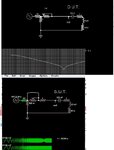anushaas
Member level 5
I need to measure impedance over a range of 1 Ohm to 3 MOhm. The impedance variation happens over a frequency range of 2 MHz to DC (ie. impedance is 3 MOhm at DC and 1 Ohm at 2 MHz).Can any one suggest a suitable measurement scheme for measurement?
I thought about a constant current excitation scheme(ie.maintaining a constant current flow through the impedance and measure the voltage across it.The impedance will be the ratio of voltage and current).But for my pplication the current cannot be less than some 75uA. This however, makes the voltage across 3MOhm equal to 225V which is too high.
The constant voltage excitation,similarly, might cause a very low or high current flow at the extremes.
Can some one help me with a possible scheme of measurement which can incorporate all the constraints?
I thought about a constant current excitation scheme(ie.maintaining a constant current flow through the impedance and measure the voltage across it.The impedance will be the ratio of voltage and current).But for my pplication the current cannot be less than some 75uA. This however, makes the voltage across 3MOhm equal to 225V which is too high.
The constant voltage excitation,similarly, might cause a very low or high current flow at the extremes.
Can some one help me with a possible scheme of measurement which can incorporate all the constraints?
